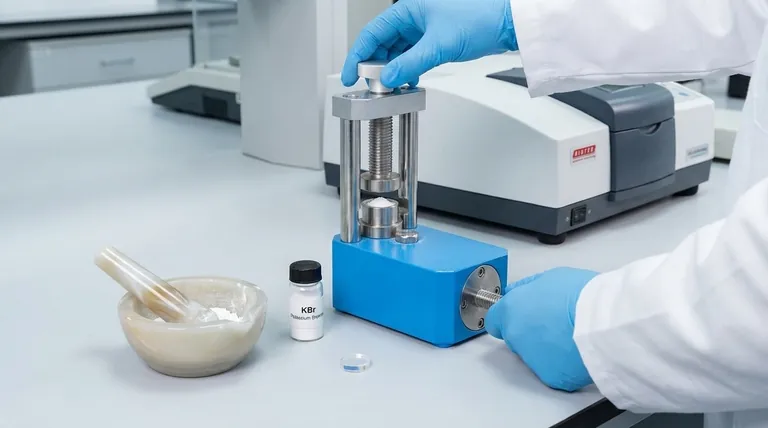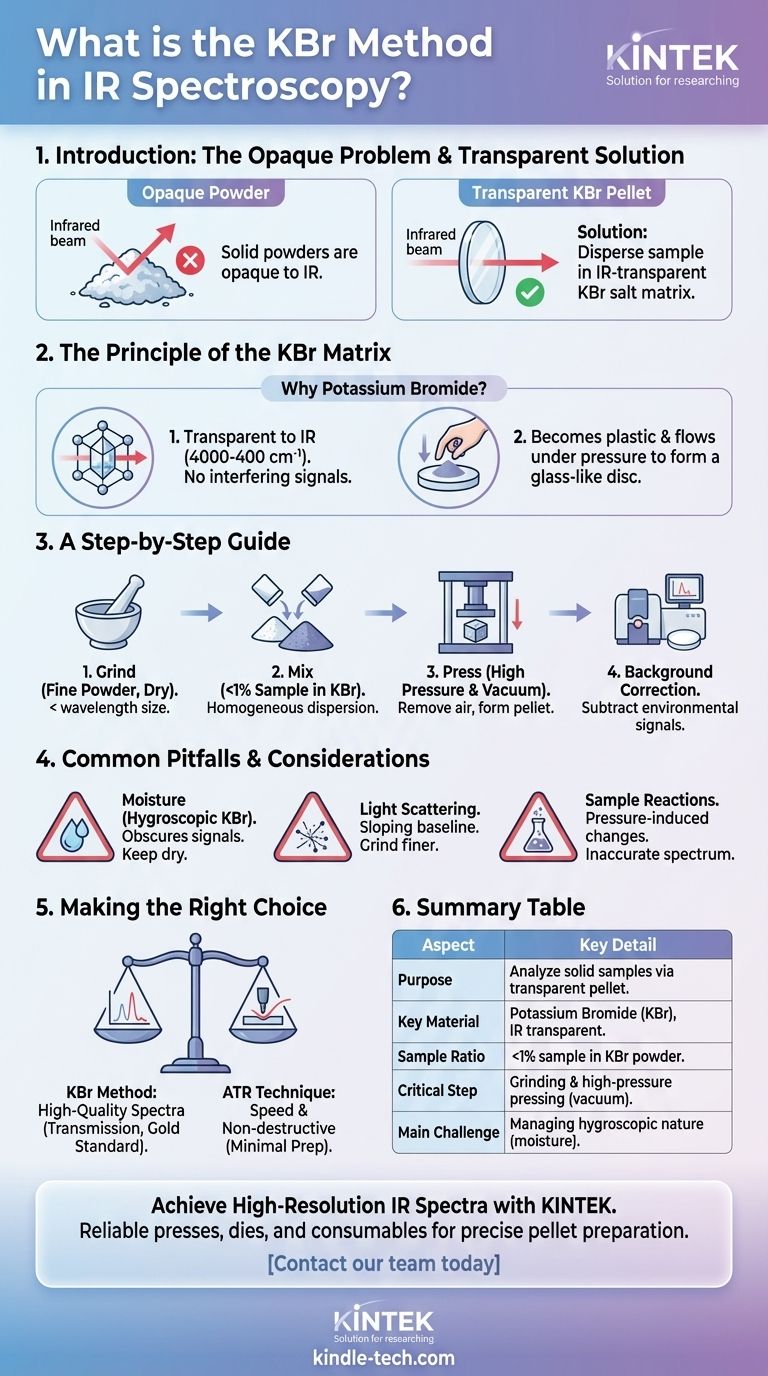赤外分光法(IR)において、KBr法は固体材料を分析するために使用される試料調製技術です。少量の試料を臭化カリウム(KBr)粉末と微粉砕し、高圧下で圧縮して薄く透明なペレットを作成します。このペレットを分光器の赤外光路に直接挿入して分析することができます。
IR分光法で固体粉末を分析する際の主な課題は、それらが通常不透明であることです。KBr法は、試料をIR透過性の塩マトリックス内に分散させることでこの問題を解決し、粉末を赤外光が通過できる「窓」に効果的に変換します。
KBrマトリックスの原理
なぜ臭化カリウムなのか?
臭化カリウム(KBr)がこの技術の標準的な選択肢であるのには、2つの重要な理由があります。第一に、KBrは最も一般的な分析範囲(4000~400 cm⁻¹)において赤外放射に対して透明であり、それ自体が干渉する信号を発生させないことを意味します。
第二に、KBrやその他のアルカリハライドは、極度の圧力下で可塑性になり流れ出すという点で独特です。この特性により、微粉末が融合してガラス状の固体ディスクになり、試料を所定の位置に保持します。
目標:均一な分散
この方法の最終的な目標は、試料の微粒子がKBrマトリックス全体に均一かつ薄く分散したペレットを作成することです。
適切な分散は光の散乱を最小限に抑え、赤外光が試料の代表的な量と相互作用することを保証し、鮮明で正確なスペクトルをもたらします。

方法のステップバイステップガイド
ステップ1:試料の粉砕
良好な結果を得るためには、試料とKBrの両方が極度に乾燥しており、細かく粉砕されている必要があります。通常、めのうの乳鉢と乳棒を使用して試料を粉砕し、散乱を減らすためにIR放射の波長よりも小さい粒子サイズにします。
ステップ2:混合
粉砕した試料の非常に少量(通常1%未満)を、より大量の乾燥したKBr粉末に加えます。これらを混合し、試料が均一に分散するように徹底的に一緒に粉砕します。
ステップ3:ペレットの加圧
混合物をダイ(金型)に入れ、油圧プレスにかけます。ペレットが不透明になったり、スペクトル干渉を引き起こしたりするのを防ぐため、ダイに真空がかけられることがよくあります。
プレスが数トンの力を加えることで、KBrが可塑化し、試料を含む透明なペレットが形成されます。
ステップ4:バックグラウンド補正
試料を分析する前に、バックグラウンドスペクトルを取得します。これは、空のペレットホルダーを使用するか、理想的には純粋なKBrで作られた「ブランク」ペレットを使用して行われます。このステップにより、機器のソフトウェアが大気中のCO₂、水蒸気、またはKBr自体の不純物による信号を差し引くことができます。
一般的な落とし穴と考慮事項
湿度の課題
KBrは吸湿性があり、大気中の湿気を容易に吸収します。水は赤外スペクトルにおいて非常に強い吸収帯を持つため、試料からの重要な信号を容易に覆い隠してしまう可能性があります。
KBr粉末や試料を含むすべての機器は、多くの場合、オーブンやデシケーターで保管することにより、徹底的に乾燥した状態に保つ必要があります。
光散乱の影響
試料粒子が十分に細かく粉砕されていない場合、それらは吸収するのではなく、赤外光を散乱させます。その結果、ベースラインが傾斜し、信号強度が低下した低品質のスペクトルが得られ、解釈が困難になります。
試料反応の可能性
ペレット形成に使用される高圧は、試料に化学的または物理的変化を引き起こすことがあります。特定の化合物はKBr自体と反応し、元の材料を表さない不正確なスペクトルにつながる可能性があります。
目的に合った適切な選択をする
KBr法は強力で古典的な技術ですが、現代的な代替手段も存在します。あなたの選択は、分析のニーズに完全に依存します。
- 高品質で高解像度のスペクトルが主な焦点である場合: 慎重に実行されたKBr法は、固体の透過測定におけるゴールドスタンダードです。
- スピードと非破壊分析が主な焦点である場合: 減衰全反射(ATR)などの技術の方が優れていることが多く、サンプル調製がほとんど不要です。
- 試料が湿気や圧力に敏感な場合: KBr法で極度の注意を払うか、アーチファクトを避けるために代替技術を選択する必要があります。
KBr法の原理を理解することで、固体試料からクリーンで信頼性の高いスペクトルデータを生成できるようになります。
要約表:
| 側面 | 重要な詳細 |
|---|---|
| 目的 | 透明なペレットを作成することにより、IR分光法で固体試料を分析する。 |
| 主要材料 | 臭化カリウム(KBr)、IR光に対して透明。 |
| 試料比率 | 通常、KBr粉末中に分散した試料は<1%。 |
| 重要なステップ | 微粉末への粉砕と、真空下での高圧印加。 |
| 主な課題 | 湿気による干渉を避けるため、KBrの吸湿性を管理すること。 |
固体試料から高解像度のIRスペクトルを得る準備はできましたか? KBr法は基礎的な技術であり、成功のためには適切な機器が不可欠です。KINTEKは、正確なペレット調製のための信頼性の高い実験室用プレス、ダイ、消耗品を提供することを専門としています。
当社の専門家は、湿気の問題を最小限に抑え、均一なペレットを保証し、鮮明で正確な結果を得るための最適なツールを選択するお手伝いをします。
お客様のラボのニーズについてご相談いただき、IR分光法の能力を向上させるために、今すぐ当社のチームにご連絡ください!
ビジュアルガイド

関連製品
- kbrペレットプレス 2t
- ラボラトリー油圧プレス 分割式電動ラボペレットプレス
- XRF & KBRペレットプレス用自動実験室油圧プレス
- FTIR用XRF&KBR鋼製リングラボ粉末ペレットプレス金型
- ラボ用自動油圧ペレットプレス機



















